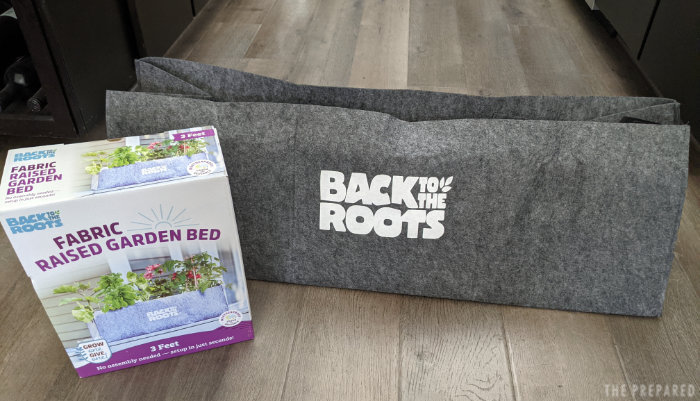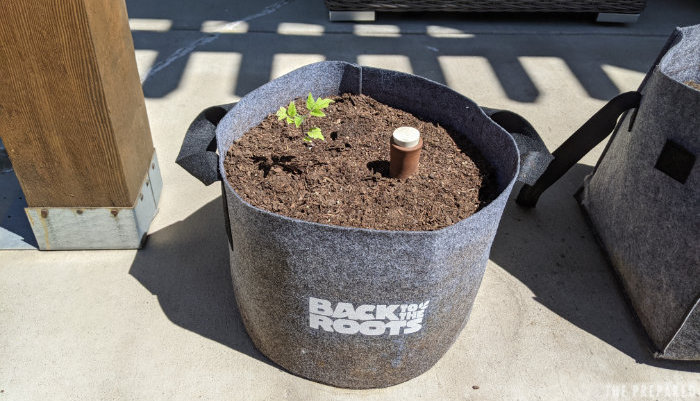Review: Back to the Roots fabric raised garden bed, self-watering Olla system, and organic seeds
Punchline: Great as a gift or a casual hobby, but not ideal for serious prepping. Last summer, I was feeling left out after reading all the inspiring posts from Josh, Redneck, and the rest of the gardening community. I decided it was time to grow something in my backyard. Unfortunately, I can't plant directly in the soil due to some issues, so I knew I needed a raised bed. However, with my busy schedule, building one myself or thoroughly researching existing options seemed like too much effort. That's when I came across Back to the Roots, and I thought I'd give it a shot. Back to the Roots is a small American company that focuses on organic seeds, potting mixes, and growing kits, including mushroom kits, hydroponics/aquaponics systems, and fabric raised beds. Their mission is to reconnect families and younger generations with the origins of food, regardless of whether you have a green thumb or access to a backyard. They’re also a B Corp-certified business. I purchased: Fabric raised beds are designed to promote healthy root growth through breathability, are easy to set up since there’s no assembly required, and the material is lightweight. Both of the beds I bought are compact enough for small spaces. The fabric beds and self-watering pots are made of thick felt, complete with stitched-in handles. The 3 cubic feet garden bed features two internal dividers, making it simple to grow different plants or create a square-foot garden. The fabric feels robust and durable. Setting up the fabric bed was straightforward—just unfold it and fill it with soil. The hardest part was transporting the soil to the bed. The self-watering pot has a 5-gallon capacity and includes a small terracotta Olla that holds approximately 20 ounces (around 2.5 cups) of water. The stopper is made of rubber. An Olla is an unglazed pot buried in the soil near the plant you wish to grow, filled with water for subsurface irrigation. This ancient technique has been used for millennia in arid regions. The Organic Beginners Garden seed pack contains cilantro, basil, onion, cherry tomatoes, spinach, arugula, lettuce, carrots, beans, and radishes. I germinated a few cherry tomatoes indoors before planting the healthiest ones in the 5-gallon fabric pot with the Olla, while sowing the radishes directly in the soil of the rectangular bed. The tomato plant did well, requiring regular feeding, which I learned is typical for tomatoes. I adjusted my watering routine accordingly. However, I quickly realized that one tomato plant wasn’t enough to sustain two people. We ended up snacking on the tomatoes as soon as they ripened. I had high expectations for the Olla, but I’m not sure I benefited significantly from it. I expected it to keep the soil moist for several days, but I found myself refilling it almost daily, and the soil still dried out quickly. Without testing the same tomatoes in a similar raised bed without an Olla, it’s difficult to make an accurate assessment. However, I suspect a combination of factors influenced the results: extreme temperatures (constantly in the high 90s to 100s), limited soil volume to retain moisture (5 gallons versus a larger bed or in-ground planting), and the fabric material of the bed. Additionally, the Olla may have been too small for such conditions (high heat + small fabric bed). The beds were placed on a concrete patio, which likely exacerbated the heat around them. Another issue I encountered was that the more I watered the beds, the more the soil collapsed the sides of the rectangular bed, lowering the soil level and casting shadows over my plants. At one point, I hesitated to add more soil because I had radishes growing inside, but this caused some radishes to chase sunlight, resulting in long stems with leaves instead of proper bulbs. One of the handles also broke when I moved the bed while it was full. It wasn’t a major problem since I shouldn’t have tried moving it once it was filled, but it was still disappointing. I also didn’t appreciate seeing the logo prominently displayed, so I turned it away from our seating area. While the logo makes sense in the context of their “Grow One, Give One†initiative (for every Back to the Roots garden photo shared on social media, they donate an organic grow kit and STEM curriculum to an elementary school of your choice), I dislike when companies make their logos overly intrusive. The gray fabric showed water and soil stains the more I used it. This is purely aesthetic and doesn’t affect functionality, but I didn’t expect it and kept noticing it until I got used to it. In summary, I’m glad I tried the fabric raised beds and the Olla. I plan to use them again next year and experiment with some of the other seeds in the pack (which could serve as a good test to see if they’ll still germinate). No, I don’t think so. If I wanted to grow enough produce for two people, I wouldn’t rely on them. I’d need more or larger beds, and there are cheaper alternatives available (though I’m curious about how different fabrics compare). I also keep thinking that fabric beds might not be the best option for my climate, and when I’m ready to expand my gardening efforts, I’d probably opt for more traditional raised beds. As for the seeds, I don’t have any reason to believe they’re inferior to other organic seeds out there, but they seem pricier ($2.99 for a pack of Back to the Roots Roma tomatoes versus $2.49 for Burpee Roma tomatoes at Home Depot—likely cheaper at a local nursery). Terracotta Ollas are pricey individually, but there are plenty of DIY tutorials online that could save money. I think every gardening kit from Back to the Roots would make a great gift for kids or adults in urban environments, or for those (like me) who want to try growing something but lack the time to plan a full-fledged garden. Even though some of their products are more expensive than shopping around, they frequently run promotions, making the prices more reasonable. For instance, they currently offer a Hydroponic/Aquaponic kit for $100 with a 25% site-wide discount, compared to nearly $150 for a similar aquaponic kit on Amazon. What I liked most about them is their focus on convenience, offering money-back guarantees, growing support, and free downloadable STEM curricula for kids. Bonus: Check out Ubique’s excellent and relevant forum post about drought preparedness and food production strategies.
1. Work chair: This is the most common type of office chair designed for use on a desk or computer. They usually have adjustable height, backrest, and armrests, and are usually mounted on wheels for easy movement.
2. Executive chair: These chairs are larger and more luxurious than task chairs, with higher backrests and more padding. They are usually made of leather and have more advanced functions such as tilting and tilting. Suitable for high-level personnel in various offices.
3. Conference chair: These chairs are designed for use in conference rooms and are usually lighter and more stackable than other office chairs, making it easier to decorate the venue. They may have adopted a more minimalist design and come with a writing pad.
Mesh Chair,Pu Chair,Leather Chair,Boss Chair Foshan Shengshi Zhihui Technology Co., Ltd. , https://www.officer-furniture.com
Are they worth it for prepping?
Who are these for?



